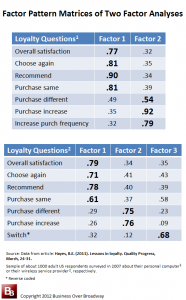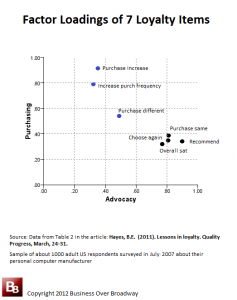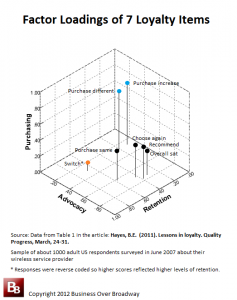 I use factor analysis (more an that below) often in my customer experience management research. Specifically, I use it to help understand how to best measure customer loyalty. The value of factor analysis, however, is sometimes lost in the details. In this post, I adopt a visual approach in presenting factor-analytic results of some prior research to help show that customer loyalty is really best conceptualized as a multi-dimensional construct, not easily captured using single-item metrics.
I use factor analysis (more an that below) often in my customer experience management research. Specifically, I use it to help understand how to best measure customer loyalty. The value of factor analysis, however, is sometimes lost in the details. In this post, I adopt a visual approach in presenting factor-analytic results of some prior research to help show that customer loyalty is really best conceptualized as a multi-dimensional construct, not easily captured using single-item metrics.
Factor Analysis
I will not go into great detail about factor analysis (For those of you who want to learn more, I recommend doing what I did: go to graduate school in a rural area where your options of “fun” are either taking a semester of factor analysis or watching the corn grow. Best environment in which to learn.). In its simplest form, Factor analysis is an excellent data reduction technique. It is used when you have a large number of variables in your data set and would like to reduce the number of variables to manageable size. In general, factor analysis examines the statistical relationships (e.g., correlations) among a large set of variables and tries to explain these correlations using a smaller number of variables (factors).
While I see great value in factor analysis in helping businesses solve their Big Data problem, factor analysis is essential to helping business understand their survey data (e.g., to create reliable, customer-centric metrics).
The results of the factor analysis are presented in tabular format called the factor pattern matrix. The factor matrix is an NxM table (N = number of original variables and M = number of underlying factors). The elements of a factor pattern matrix represent the regression coefficients (like a correlation coefficient) between each of the variables and the factors. These elements (or factor loadings) represent the strength of relationship between the variables and each of the underlying factors. The results of the factor analysis tells us two things:
- number of underlying factors that describe the initial set of variables
- which variables are best represented by each factor
Measuring Customer Loyalty
Last year, I published an article on the measurement and meaning of customer loyalty (Lessons in Loyalty). In that article, I presented evidence that customer loyalty is really a multidimensional construct. The loyalty questions I used were:
- Overall, how satisfied are you with
? (0 – Extremely dissatisfied to 10 – Extremely satisfied) - If you were selecting a wireless service provider (personal computer) for the first time, how likely is it that you would choose
? (0 – Not at all likely to 10 – Extremely likely) - How likely are you to recommend
to your friends/colleagues? (0 – Not at all likely to 10 – Extremely likely) - How likely are you to continue purchasing the same product and/or service (product) from
? (0 – Not at all likely to 10 – Extremely likely) - How likely are you to purchase different products and/or services (products) from
? (0 – Not at all likely to 10 – Extremely likely) - How likely are you to increase the amount of products and/or services (products) you purchase from
? (0 – Not at all likely to 10 – Extremely likely) - How likely are you to increase the frequency with which you purchase products from
? (0 – Not at all likely to 10 – Extremely likely) (Only used in PC Manufacturer study) - How likely are you to switch to another provider? (0 – Not at all likely to 10 – Extremely likely) (Only used in Wireless study)

Table 1. Factor pattern matrices of two factor analyses: Top: PC Manufacturers; Bottom: Wireless Service Providers
Factor Pattern Matrix
I conducted two factor analyses of seven (7) different customer loyalty questions, one for the PC industry and the other for the wireless service provider industry, respectively. The factor pattern matrices are presented in Table 1. The results of the factor analyses reveal that the seven loyalty questions can be boiled down to fewer factors, suggesting that the specific loyalty questions really only measure a few types of customer loyalty.
Generally speaking, the results of these two separate factor analyses reveal that customer loyalty can be boiled down to a few types of loyalty. Labeling of factors is part art, part science and occurs after the number of factors is established. The label needs to reflect the content of the questions that are highly related to it. (I call it Advocacy Loyalty); the next set of loyalty questions that have similar factor loadings measure something else (I call it Purchasing Loyalty). And the last loyalty question (for wireless only) measures something different from all other loyalty questions (I call it Retention Loyalty).
Visualizing Customer Loyalty
By plotting the factor loadings of each question in graphical form, we see the location of the items in a factor space (Sounds cool, I know!). This plot is a visual representation of what each question is measuring. You might think of the plot space as the concept of customer loyalty, and where each item falls in this customer loyalty factor space tells us what type of customer loyalty each question is measuring. As they say, a picture is worth a thousand words, and taking a visual approach provides a more much holistic look at the measurement and meaning of customer loyalty (e.g., Which loyalty questions give similar results? Do loyalty questions mean different things across different industries?).

Figure 1. Plot of factor loadings for 7 different customer loyalty questions reveals two general types of customer loyalty
Figure 1 represents the plot (specifically a scatter plot) of the factor loadings from the PC Manufacturers study. Because the factor analysis resulted in only two factors, this plot has only two axes. Advocacy (Factor 1) is the X-axis. Purchasing (Factor 2) is the y-axis. Figure 2 represents a 3-dimensional plot of the factor loadings from the Wireless Service Provider study. The factor analysis revealed a 3-factor solution, so to plot these loyalty questions, we have added an additional z-axis (Retention). Each question is color-coded to reflect the factor on which it has its highest loading (Advocacy questions in black; Purchasing questions in blue; Retention question in orange).
Meaning of Customer Loyalty
Looking at the plots, we can make a few quick judgments about each the customer loyalty questions and customer loyalty:
- There are distinct types of customer loyalty. This series of studies supports the idea that there are three types of customer loyalty: retention, advocacy and purchasing
- Advocacy loyalty reflects a general positive attitude toward the company/brand. Compared to purchasing loyalty, demonstrating advocacy loyalty requires little effort on the part of the customer. Also, the advocacy loyalty questions appear to have elements of purchasing and retention loyalty.
- Purchasing loyalty reflects the customers’ clear intent to deepen the relationship the relationship with the company and brand. This extra effort required by the customer differentiates these questions from the standard “purchase same” question. Also, the purchasing loyalty questions are clearly distinct from the other types of customer loyalty (not influenced by advocacy or retention).
- Retention loyalty reflects the customer’s intent to cut ties with the relationship. Similar to purchasing loyalty, retention loyalty, as measured here with the “switching” question, requires a non-trivial amount of effort by the customer.
- Retention and Advocacy loyalty are related yet different. We see that the “switching” question measures something different than the “purchase same” question. Even though poor ratings on either question result in the same outcome (customer is gone), they appear to be tapping different mental processes of the survey taker. Asking somebody if they will stay (purchase same) could be more of a function of the quality of the service/products they are provided and asking somebody if they intend to leave is more of a function of their personal values (price driven customer).

Figure 2. Plot of factor loadings for 7 different customer loyalty questions reveals three general types of customer loyalty
Measuring Customer Loyalty Via Surveys
Customer relationship surveys, the foundation of many customer experience management (CEM) programs, are used to measure customer loyalty, along with other important customer variables (e.g., satisfaction with their experience). Including the right loyalty questions in your customer survey is essential to an effective CEM program.
The Value of Different Customer Loyalty Questions
Including the right customer loyalty questions requires careful thought about your customers and your business. Different types of loyalty questions have been shown to be predictive of different types of business growth. Managing and improving each type of customer loyalty will have a direct impact on revenue. Managing advocacy loyalty will help drive new customer growth. Managing purchasing loyalty will drive existing customer growth by increasing average revenue per user (ARPU). Finally, managing retention loyalty will drive overall size of the customer base.
RAPID Loyalty Approach
These three distinct types of customer loyalty form the foundation of the RAPID loyalty approach. Using the RAPID loyalty’s multi-faceted approach helps companies understand how improving the customer experience can improve business growth in different ways. If interested, you can read my recent article on the development of the RAPID loyalty approach.



